Have you ever looked at a vehicle and wondered how the manufacturer came up wth its name? I suspect you didn’t have that issue when you first saw the Volkswagen Atlas.
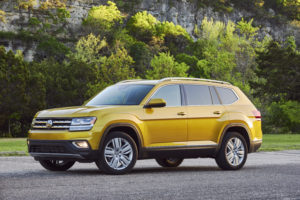
image courtesy Volkswagen
I spent a week with the Execline trim, including Captain’s package.
First impressions
The name aptly describes the size and form of this, Volkswagen’s unapologetically bulky, muscular three-row all-wheel-drive SUV. In certain parking lots, I had mere inches to spare between the lines that defined my spot. Its length usually proved a tight fit as well.
Volkswagen broke away from the crowd by making the roofline almost perfectly level from the driver’s seat to the rear hatch, further contributing to the impression of size. Defining lines aside, the Atlas does look like an intimidating, if stylish, box on wheels that would fit in well on visits to a British country estate.
Interior
Roominess is the operative word here. The Atlas offers generous headroom and legroom throughout the cabin. I sat in the third row for a few moments to test this and found that I could actually sit there without bending my head. I’m 6’5” tall, so that’s saying something.
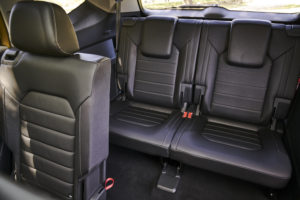
image courtesy Volkswagen
The seat backs are low, so Volkswagen fitted tall headrests here that improve upper-body support. (You’ll need to raise the headrest to prevent it from poking into the longitudinal centre of your back.) Amenities in the back are limited to a vent on each side of the vehicle, plus the leather that adorns every seat in the cabin. That said, when you factor in the roominess and relative ease of entry and egress, this may be one of the best third-row experiences in the the SUV market.
The second row wasn’t bad either, thanks to the Captain’s Package. Two bucket heated seats featured centre armrests and oodles of legroom. Passengers here also get climate controls and USB ports to charge their devices.
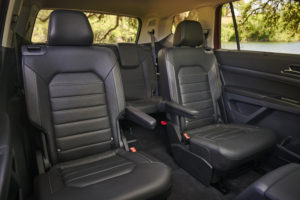
image courtesy Volkswagen
Power-adjustable heated and cooled front seats proved great on long rides.
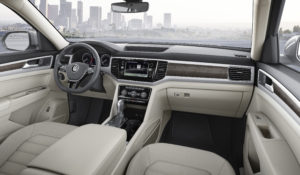
image courtesy Volkswagen
A heated steering wheel is always great on chilly days. The driver’s seat features three seat memories, a hint at the market VW targets with the Atlas. The centre console is wide, as is typical in vehicles this size regardless of manufacturer. It’s a design choice that seems to psychologically reinforce the vehicle’s off-road capabilities.
Second- and third-row passengers need only turn their eyes upward to view the skuy during a drive, thanks to the panoramic moonroof that runs the length of the vehicle. Designers touched up the well-appointed interior using subtle ambient lighting on the doors, dash, even the driver’s footwell.
Hockey bag test
The bag fits latitudinally and the liftgate closes easily – once I shove my gear a little to make the bag a little narrower. I managed this while leaving the third row of seats in position. If folded down, the Atlas is ready for trips to hockey tournaments.
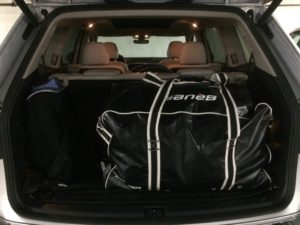
In-cabin technology
The fully-loaded infotainment system shows itself to the driver via the 8” touchscreen. As always, buttons appear along the bottom of the screen in a dock reminiscent of the one in macOS whenever a hand approaches it. That dock sinks back down when the hand recedes. Apple CarPlay and Android Auto offer smartphone-tailored experiences if you would rather forego Volkswagen’s built-in systems.
Audio comes through a 12-speaker (plus subwoofer) Fender audio system. 12 speakers may sound like a lot – OK, it IS a lot – but every one of those speakers is justified by the cavernous cabin.
Volkswagen outfit my Atlas using its digital cockpit.
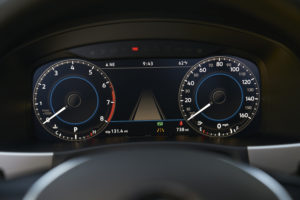
image courtesy Volkswagen
In other words, the whole instrument cluster is a screen. Digital representations of an analog tach and speedo dominate the screen, though VW puts extra information in each one. For example, a blue real-time fuel economy “dial” resides in the middle of the tachometer. The current cruise control speed appears not jsut as a number at the bottom centre of the screen but also a green dash at the appropriate place on the speedometer. Adaptive cruise control means that when you cruise at slower speeds, the rim between actual and set speed shows as green. Lower the set speed and the rim glows red until the vehicle hits your new set speed.
Driving
A 3.6L 276 hp engine drives all four wheels via an 8-speed automatic transmission. Other trim levels can be had with a 2.0L 235 hp engine and the same 8-speed transmission.
Ride quality is smooth and confident. The adaptive cruise control system has the typical VW tendency of eagerly accelerating when the lane ahead clears up, so I kept my foot near the brake in case another vehicle decided to nip into that space. I had no such issues in stop-and-go traffic, where the system needed no prompting outside of the occasional stop that lasted longer than a second or two. The Atlas also offers drive modes, like Offroad and Snow, that people are likely to understand and use.
My awareness habitually rises any time I drive or walk through a parking area. That awareness goes up whenever I drive an Atlas-sized vehicle. So kudos to VW for including not just a rear-view camera but a full Area View 360-degree “bird’s-eye view” of everything around the Atlas. I’m starting to think this years-old technlogy ought to be standard equipment on any vehicle this size. (Note to VW: Please put the camera behind the VW roundel, the way you do for the Beetle, to protect the lens from the elements.)
I also appreciated proximity sensors that beep at you from the speaker near the part of the Atlas that happens to be close to an obstacle (think parking garage pillar, vehicle, wall, etc.). As they beep, the centre of the instrument cluster screen shows what part of the vehicle happens to be approaching the obstacle. (This low-speed technology also activated during certain bouts of stop-and-go highway driving.)
Park Assist isn’t as widespread an automotive technology, so it’s fun to see the look on other people’s faces when you have the Atlas parallel park itself.
The comprehensive active safety set of technologies includes blind spot detection, rear cross-traffic alert and lane-keep assist (with haptic feedback through the steering wheel).
Fuel economy
VW publishes fuel economy numbers of 8.9 L/100km highway and 10.8 L/100km city. I suppose these numbers might happen on longer trips. At its best, fuel economy readouts dipped below 9.4 L/100km on the longest highway trip I could manage during my week with the Atlas.
Start/stop technology helps by frequently killing the engine while I idled, whether at red light, stop signs, or simply waiting for a passenger to get in. Regardless, the Atlas gets fuel economy that you might expect from a 3-row SUV in city driving.
Pricing
The 2018 Volkswagen Atlas sells for an MSRP of $53,440, excluding options and other charges. The Captain’s Package is yours for an extra $625. Base MSRP (Trendline trim) is $35,690.